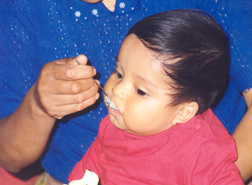This page has been archived and is being provided for reference purposes only. The page is no longer being updated, and therefore, links on the page may be invalid.
|
Read the magazine story to find out more. |
|
|
|
|
Increasing Iron Uptake in Infants
By Ann PerryMarch 10, 2008
Researchers with the Agricultural Research Service (ARS) and Cornell University have developed new techniques for boosting the amount of iron infants absorb from solid food.
Children who are five to six months old are growing rapidly and need sufficient iron to fuel their development. However, this is also the time when an infant's first iron reserves start becoming depleted.
Physiologist Raymond Glahn at the ARS Plant, Soil and Nutrition Research Unit in Ithaca, N.Y., worked with Cornell nutritionist Rebecca Stoltzfus and graduate student Helena Pachón (who now works at Colombia's International Center for Tropical Agriculture) to find ways to increase infants' iron uptake.
The team processed freeze-dried samples of chicken liver and beef in a blender, which reduced the meat to small, uniform particles. They found that these particles--which become distributed evenly throughout cereals because of their size and consistency--can serve as a source of supplementary iron for infants.
In addition, in vitro tests indicated that iron uptake from cereal supplemented with the beef particles was greater when blending time was increased. Chicken liver particles processed in a blender for six minutes resulted in more than twice as much iron uptake than chicken liver blended for just 60 seconds.
This research can help address iron deficiency-induced anemia, a problem that affects as much as one-third of the global population. In developing countries, infants and children are especially susceptible to anemia because the solid foods they eat are often low in iron. In addition, they may not be able to absorb the iron efficiently.
Adding ingredients such as chicken thigh or chicken liver to infant meals can provide impoverished communities with more heme iron. This form of iron, which contains molecules of hemoglobin and myoglobin, is more easily absorbed and used by the body for nutritional health.
This work was funded by ARS, the National Institutes of Health, and Kraft Foods.
Read more about the research in the March 2008 issue of Agricultural Research magazine.
ARS is the U.S. Department of Agriculture's chief scientific research agency.

